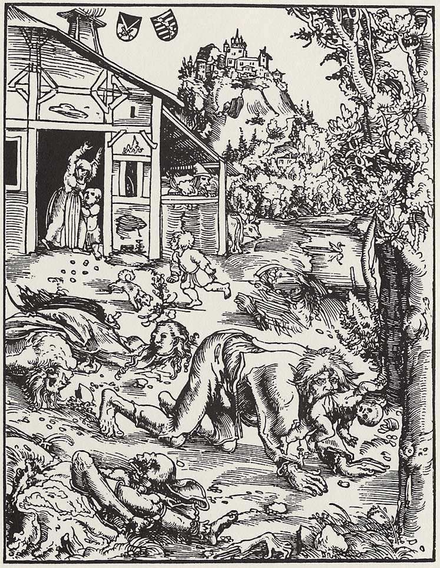Stories of witchcraft are as old as time, and the concept of “witches” is one that spans many countries and cultures. Throughout the centuries witches, or simply those suspected of witchcraft, have been hunted and persecuted by mainstream society. There are many different types of witches, including kitchen witches, hedge witches, bruja, and daayan – all with their own beliefs, practices, and conflicted history. However, across categories one fact remains the same: witches are powerful.
Given the diversity in witches and witch folklore, it’s no surprise that stories involving witches are just as varied. We at Puzzle Box Horror want to acknowledge that the term “witch” should not be an inherently negative one, and there are many practicing witches and pagan communities that are a boon to society. Our goal with this article is not to disparage witchcraft in general, but rather to explore the darker side of the coin. With that in mind, we’d like to present some of the scariest witches in literature.
Maggie’s Grave by David Sodergren (2020)
MAGGIE WALL BURIED HERE AS A WITCH. So reads the faded inscription on the solitary grave at the top of a mountain. In the shadow of this mountain is Auchenmullan, a small Scottish town that has been left forgotten and lost to the world. Only forty-seven residents remain, plus the grave on the mountain. In a dead town with nothing to do, the residents suddenly find themselves confronted by the chilling fact that sometimes the dead don’t stay buried. Especially when they have unfinished business.
Maggie’s Grave is a shocking, disturbing, and fast-paced thrill ride of witchy horror. The buckets of blood, the flawed characters, the gross-out moments, and the folk horror elements will linger in your mind long after you’ve finished reading.
The Remaking by Clay McLeod Chapman (2020)
In the 1970s, Amber Pendleton was cast in a horror film titled Witch Girl of Pilot’s Creek, based on a true story of a mother and her daughter who were burned at the stake for witchcraft. Then, in the 1990s, Amber was cast in a remake of the cult classic movie. Now Amber herself has become the target of a witch hunt. In an attempt to free herself from this cycle of horror, she decides to tell her story one last time to a true crime investigator for his popular podcast. But will this retelling bring the closure she needs, or will it unlock a dark and vengeful force from the past?
The book brilliantly engages with four different versions of the same urban legend, while also populating each version with interesting characters and shocking incidents. This unsettling read will be sure to please fans of both horror and true crime!
Devil’s Call by J Danielle Dorn (2017)
A western horror with witches? Say no more! Devil’s Call is written in the form of a diary from a pregnant mother to her unborn child. One wintry night in 1859, Li Lian’s husband was shot dead right in front of her. Unfortunately for the men who did this dirty deed, Li is part of the McPherson clan, a long line of women gifted in the dark arts of witchcraft. In the diary Li recounts how she crosses miles of harsh land and numerous odds to hunt down the monsters who killed her husband.
With her rifle, her wits, and her powers of witchcraft, Li is truly a terrifying force to be reckoned with. It’s a supernatural tale of vengeance and motherhood set in the wild west, and it’s a must-read for lovers of witchy horror.
The Witching House by Brian Moreland (2017)
Sarah Donovan is scared of just about everything, from heights, to tight places, to the dark. But when her boyfriend wants to go explore a supposedly haunted house in the woods, she must swallow her insecurities and face her fears. The house in question was the scene of a brutal massacre in the 70s, where twenty-five people were killed and whose perpetrator remains a mystery. But the hauntings in the house are more than just urban legends, and Sarah is about to find out that the evil residing in the basement has simply been waiting for fresh prey.
The Witching House veers away from copious blood and gore, instead delivering a fast-paced tale of suspense and pulse-pounding terror. It’s a lean horror novella, one you can fly through while also reveling in all the twists and turns of the unique storyline.
Wytches by Scott Snyder (2015)
The Rooks family, hoping to escape from a haunting trauma, has recently moved to the remote town of Litchfield, New Hampshire. They’re hopeful for a new life and a fresh start, but the ancient evil watching them from the woods has other plans…and it’s hungry.
Wytches posits a world where witches are darker and more terrifying than previously imagined, throwing out cliched tropes in favor of creepier creatures. The story is surprisingly emotional while also unsurprisingly bone-chilling, and is one of the absolute scariest graphic novels about witches we’ve ever seen (thanks in part to the nightmarish imagery from artist Jock). This volume collects issues 1-6 of the miniseries from Image Comics.
The Good House by Tananarive Due (2006)
Looking for a sweeping and spooky saga of family, loss, grief, and witches? Then look no further! Angela Toussaint has spent the last few years burying herself in her work, trying to rebuild her law practice after her son Corey committed suicide at a Fourth of July party. Unable to keep her questions at bay any longer, she eventually returns to the house where it all happened and looks for answers. However, the dark forces she discovers are more sinister than she could have imagined.
This epic 500 page book takes its time, allowing you to learn more about the Toussaint family, the surrounding town of Sacajawea, and the Good House itself. But there is a constant building dread, and when the horrors hit, they hit hard. Even seasoned horror readers will find themselves spooked by this tale of ancestral evil and voodoo witchcraft.
Harvest Home by Thomas Tryon (1973)
Time has not touched the village of Cornwall Coombe, a small town in New England. The quant colonial homes and white-steepled church seem to exist outside of modern life, and life in the village seems peaceful and easygoing. Newcomers Ned and Beth Constantine fall in love with this remote hamlet, assuming they’ve found the safe haven they’ve always dreamed of. Unfortunately, what they find instead is a disturbing and wicked force that turns Cornwall Coombe into a place of ultimate horror.
This book plays well to its folk horror roots, with its emphasis on rural life, dark pagan secrets, and evil in a small town. It’s definitely a slow-burn horror, but it maintains a high level of tension throughout while also delivering complex characters and a fascinating, if unnerving, storyline. Mysterious omens, brutal violence, and terrifying witchcraft – Harvest Home is one not to be missed!
Other Recommendations
The Devil’s Mistress by David Barclay (2021)
The Year of Witching by Alexis Henderson (2020)
Hex by Thomas Olde Heuvelt (2016)
The Lords of Salem by Rob Zombie and BK Evenson (2013)
White is for Witching by Helen Oyeyemi (2009)
The Witching Hour by Anne Rice (2004)

Ben’s love for horror began at a young age when he devoured books like the Goosebumps series and the various scary stories of Alvin Schwartz. Growing up he spent an unholy amount of time binge watching horror films and staying up till the early hours of the morning playing games like Resident Evil and Silent Hill. Since then his love for the genre has only increased, expanding to include all manner of subgenres and mediums. He firmly believes in the power of horror to create an imaginative space for exploring our connection to each other and the universe, but he also appreciates the pure entertainment of B movies and splatterpunk fiction.
Nowadays you can find Ben hustling his skills as a freelance writer and editor. When he’s not building his portfolio or spending time with his wife and two kids, he’s immersing himself in his reading and writing. Though he loves horror in all forms, he has a particular penchant for indie authors and publishers. He is a proud supporter of the horror community and spends much of his free time reviewing and promoting the books/comics you need to be reading right now!



